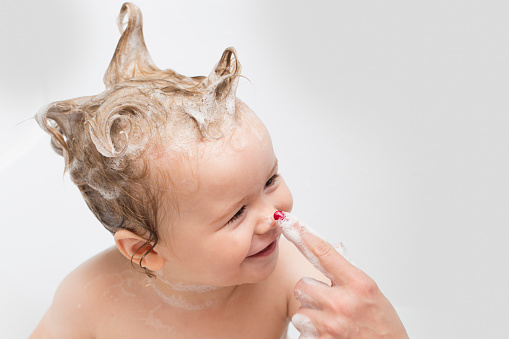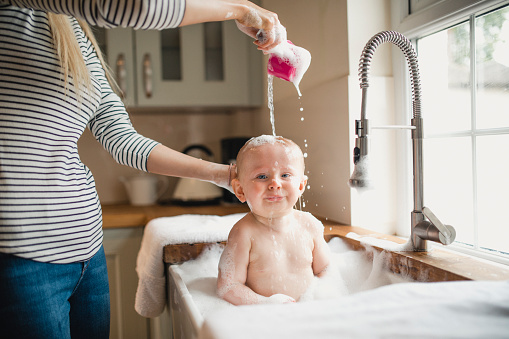Having welcomed your new baby, you’ve got apprehensions and questions about how to provide the best care. Yours may be blessed with a mop of luscious locks, or maybe just a few. However, you now realize that your baby’s head is grimy, but still unsure when to wash newborn hair for the first time.
Start washing your newborn’s hair after four to six weeks after birth. Seeing as your baby’s skin is still sensitive, try avoiding any cleansers, at least for the first month. In the meantime, you can keep your tots head clean with regular wipes using a soft wet cloth, especially when top tailing.
The state of your newborn’s hair will determine when you decide to shampoo. Always go with fragrance and dye-fee products designed for your baby’s sensitive scalp. Follow these tips to know how and at what stage you’ll start shampooing your baby’s head.
When Should I Start Washing My Newborn’s Hair?
Washing your baby’s hair, when you finally get round to it, is similar to bathing your newborn. Regular washes, more than once or twice a week, will remove the necessary oils needed to keep your tot’s scalp healthy. It’ll be safer to use a sponge during the first month or so of your baby’s life, and that should be sufficient to keep their head clean.

You can start washing your newborn’s hair in the second or third month. That’s when you’ll have started moving around with babies, exposing them to a bit of sunshine. Even if you’ll stay indoors and the weather has been sticky, it’ll be a good idea to shampoo your tot’s head.
Is Cradle Crap Caused by Not Washing My Newborn’s Hair?
Sometimes, you’ll find your baby with cradle cap, a type of rash called infantile seborrheic dermatitis. That’s your newborn’s first encounter with dreadful dandruff, but it’s common, non-contagious, and harmless. You’re probably more bothered about the sight of brown, red, white, or yellow flakes than is your newborn.
It’s not exactly known what causes cradle cap. Studies suggest that pregnancy hormones cause the production of a natural antifungal serum called sebum. Others attribute it to Malassezia, yeast growing alongside the sebum, and other coliforms.
In a severe case of cradle cap, it may spread to your baby’s face or body, sometimes in patches or tiny hanging pieces. Then you should contact your pediatrician, who will recommend mild baby shampoo, along with regular anti-yeast medication like 1% hydrocortisone cream.
Soft brushing also helps remove the scales but avoids anti-seborrheic shampoos that contain 2% salicylic acid or sulfur. While effective at loosening the cradle cap, these will irritate your newborn’s sensitive skin. Petroleum or petrolatum jellies and some ointments can work, but avoid baby oils as these only enhance scale buildup.
What Other Benefits Are There for Washing My Newborn’s Hair?
Avoid submerging your newborn in water if they haven’t lost their umbilical cord stump, or are still recovering from a circumcision procedure. You can wash your baby’s hair while laying them on a towel, after which you may wipe their body down with a warm, wet cloth.
Keeping your child’s head clean and preventing or reducing cradle cap are some of the obvious benefits of washing your tot’s hair. Others include;
Preventing Ringworm
Ringworm is a common skin infection that affects babies and young children, appearing mostly on the scalp. Contrary to popular belief, the oval-shaped, scaly rashes aren’t caused by a worm, but fungi called tinea, and it’s highly contagious. These scales can become red, dry, and itchy, and your pediatrician can prescribe medicated shampoo, ointment, or antifungal cream.

If a ringworm infection doesn’t clear with topical application, your newborn may require oral medication. You can prevent the occurrence of this fungal infection with regular hair washes using a baby-friendly shampoo.
Preventing Dandruff
Other than the ‘dandruffy’ cradle cap, washing your baby’s hair regularly will prevent similar conditions. Eczema, excess of oil, dry scalp, or fungal infection can all cause dandruff. While not contagious, these conditions can make your newborn itch, but you can prevent it by using a gentle moisturizing shampoo.
That’s unless your baby has eczema, often exacerbated by shampoos. Call your pediatrician instead and follow whatever advice they’ll suggest, such as using a skin-soothing emollient shampoo. You can deal with dandruff caused by excess oils with more frequent washes of your newborn’s hair.
How Do I Wash My Newborn’s Baby Hair for the First Time?
You now know when you need to start washing your baby’s hair. Now let me go through a simple procedure of doing that. The first time may only include water unless your tot’s hair is extra grimy or there are signs of cradle cap and other causes of dandruff. Collect all that you need and set a designated area within which to wash your tots head. You’ll need;
- A basin, sink, or baby’s tub
- Washcloth
- Towel
- Baby-friendly shampoo with moisturizer
- Optional hair cream or oil
Fill the tub with up to four inches of warm water and check that the water is 100° Fahrenheit or lower using a thermometer. If you don’t have one, feel the temperature with the inside of your elbow or wrist. It burns; it’s too hot for your newborn’s scalp.
You can bathe your baby’s body first if you’ve started doing that, otherwise hold them on the back, feet towards your torso, holding their head and neck. Wet your little one’s scalp using a cup or wet cloth, and then apply a pea-sized portion of baby shampoo. Lather their hair without too much or vigorous rubbing.
Rinse out the shampoo by alternating between sweeping back with your hand and pouring water on your tot’s head. Use a washcloth to prevent suds from getting into your baby’s eyes. Once rinsing gets done, dry your newborn’s head, especially if the room temperature is cold. A hooded towel helps prevent your baby from losing heat through their head.
Conclusion
Wash your newborn’s hair when the baby is at least four to six weeks old. You can use warm water only or supplement it with a very gentle and mild moisturizing shampoo. Remember that at first, your baby may be slippery, uncomfortable, or outright frightened by a hair washing experience. Do the shampooing slowly, supporting their heads while ensuring you’re using a firm base such as a changing table, floor, or bed.

I’m Cathrine and I’m a 39-year-old mother of 3 from Utica, New York. And I’m extremely happy you’ve come to visit my hide-out on the web. Here I post about everything related to family-life and usually it will involve babies and lessons I’ve learned over the years from experts, friends, and my own mistakes. So hopefully you will find what i write fun and informational!

